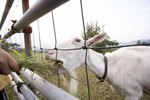
When it comes to goats, everything you put inside their area needs to be as durable as possible. Even the best-designed commercial feeders are going to get pushed around, beat up and in many cases destroyed. Luckily, goats are not interested in designer things; you can make your own goat feeders with recycled or inexpensive materials at a fraction of the cost.
Materials
The materials you'll need to make homemade goat feeders will depend on the type of feeders -- grain, hay or minerals -- you intend to make. Be on the lookout for suitable scrap. Materials may include various pieces of dimensional lumber and plywood, PVC pipes in various widths, chain, screws, nails, and PVC primer and cement. Basic tools include a tape measure, drills, saws and hammers. Check with local resale stores or a local construction company for excess materials left over from a project. These sell at a discount or, if you are lucky, given away free. Pick up a few wooden pallets as well as they easily convert into quick feeders.
Trough Feeder
Trough feeders provide a place to serve grain or goat pellets. The 4-inch diameter PVC used for plumbing creates a wide-enough trough. Determine the length of trough you desire and cut the PVC to length. Split the PVC length in half, creating two half-moon pieces. Place a piece of 2-inch treated lumber ate one end of the trough. Trace the shape of the curve onto the wood. Cut two pieces of wood to this shape to create the end caps of your trough. Place the pieces inside the PVC pipe and secure with wood screws. Screw an eyebolt into the top of each piece of wood. Attach a chain to each piece and hang the trough from independent fence posts in the center of the pasture or from the fence posts of an existing fence.
Hay Feeder
Hay feeders require openings that are large enough for the goats to access the hay but small enough that the goats do not get their heads stuck. A collection of 2-by-4 board pieces put together to make a crate with spaced slats will work. For large herds requiring a lot of hay, a simple cube made from five wooden pallets screwed together will work. To cover the top and keep rain out of the hay, attach a piece of plywood to the top with hinges.
Loose Mineral Feeder
Goats require free-fed loose minerals to supplement their diet. PVC pipe makes a durable mineral feeder that takes just a few steps. You need 4-inch PVC pipe along with one 45-degree elbow connector, an end cap, a female adapter and a male threaded cap. To seal the feeder, you need PVC primer and cement. Apply the primer to one end of the PVC pipe as well as the top opening in the 45-degree elbow connecter. Allow the primer to sit for a few minutes. Apply a thin layer of the cement to both sections and immediately push the pipe into the connector. At this point, you have a long pipe with the opening of the elbow connector facing upward, similar to the letter J. Repeat this process with the other end of the connector and the female adapter. Screw in the male cap to close the bottom. Allow the feeder to sit for 24 hours before proceeding. Hang the feeder by drilling holes in the PVC and attaching chain or rope to tie. As an alternative, drill the feeder directly onto a wall in the goat shelter. Fill with loose minerals at the top and close with the end cap.
References
Photo Credits
-
Jupiterimages/Pixland/Getty Images
Writer Bio
Deborah Lundin is a professional writer with more than 20 years of experience in the medical field and as a small business owner. She studied medical science and sociology at Northern Illinois University. Her passions and interests include fitness, health, healthy eating, children and pets.



